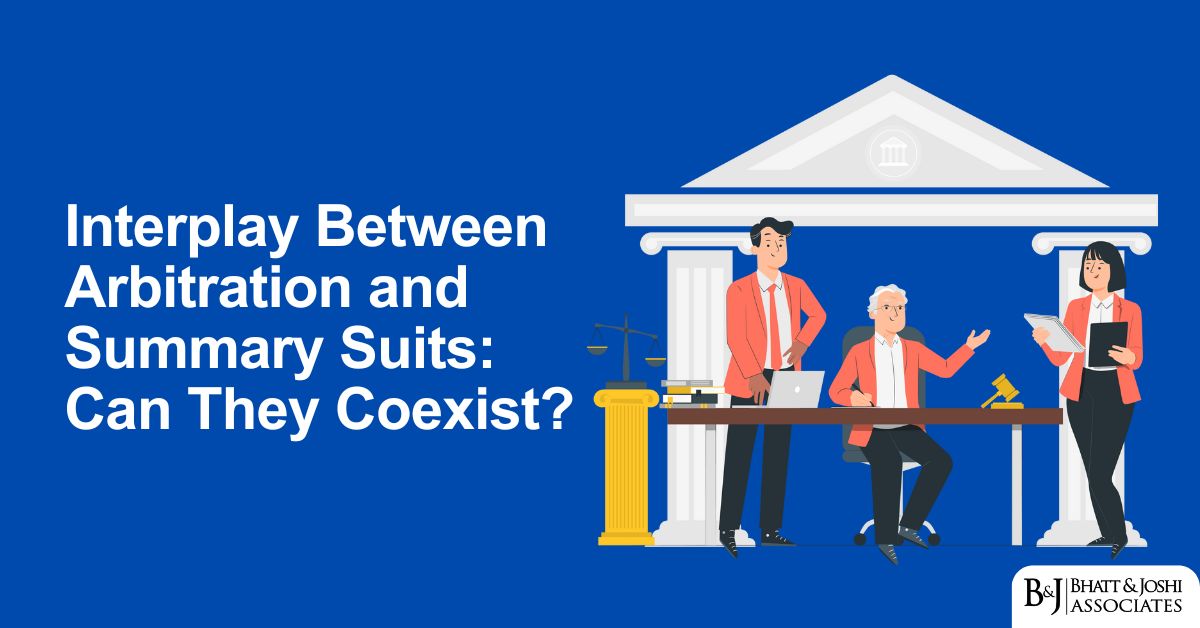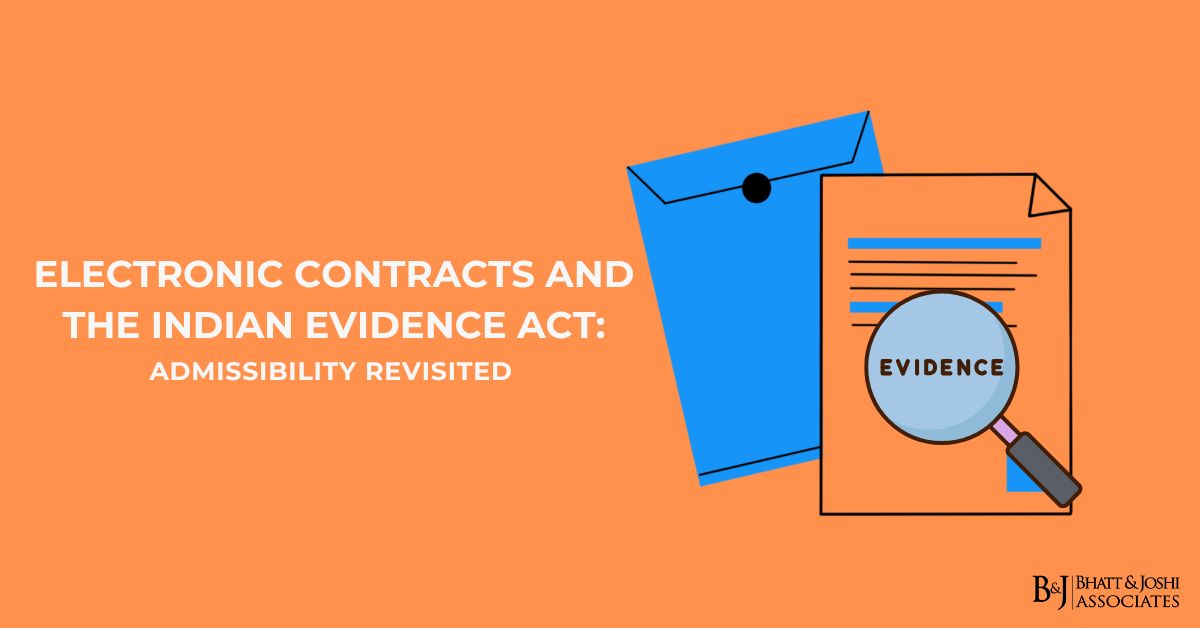Introduction
The Indian legal landscape offers two distinct expedited mechanisms for commercial dispute resolution: arbitration under the Arbitration and Conciliation Act, 1996, and summary suits under Order XXXVII of the Code of Civil Procedure, 1908. While arbitration provides party autonomy, procedural flexibility, and specialized adjudication through a consensual private process, summary suits offer an accelerated judicial pathway for certain categories of claims where elaborate proceedings are deemed unnecessary. The coexistence of these parallel mechanisms creates complex jurisdictional questions when a dispute potentially falls within the ambit of both regimes—particularly when a matter covered by an arbitration agreement also qualifies for summary adjudication.
This tension between arbitration agreements and summary suit proceedings has generated substantial litigation, with courts developing nuanced jurisprudence on whether, when, and how these mechanisms can coexist. The questions raised are fundamental: Does an arbitration agreement automatically preclude recourse to summary proceedings? Can a party legitimately bypass an arbitration clause by framing its claim to fit within Order XXXVII? Should courts prioritize the sanctity of arbitration agreements over the efficiency objectives of summary procedures? These questions implicate core principles of contractual freedom, judicial economy, and procedural justice.
This article examines the evolving jurisprudence on the interplay between arbitration and summary suits, analyzing landmark judgments, identifying emerging judicial principles, and evaluating how courts have balanced competing policy considerations. Through this analysis, the article aims to provide clarity on whether and under what circumstances these mechanisms can meaningfully coexist within India’s commercial dispute resolution framework.
Summary Suits and Arbitration: A Comparative Legal Framework
Summary Suits: Judicial Fast-Track
Order XXXVII of the Code of Civil Procedure establishes a specialized procedure for certain categories of claims, principally those relating to bills of exchange, hundis, promissory notes, or recovery of debt or liquidated demands. The distinctive feature of this procedure is the initial presumption against defense—the defendant must obtain leave from the court to defend the suit, which will be granted only upon demonstrating substantial triable issues.
In HDFC Bank Ltd. v. Satpal Singh Bakshi (2013) 1 SCC 177, the Supreme Court described the essence of summary procedure:
“The object of the summary procedure is to prevent unreasonable obstruction by a defendant who has no defense. The provision for the summary judgment in a summary suit has been held to be just and necessary, as it prevents the defendant from obtaining delay by merely filing a written statement and enabling the defendant to prolong the litigation and prevent the plaintiff from obtaining an expeditious remedy. While Section 34 of the Code arms both plaintiff and defendant with the power to initiate any suit of a civil nature, Order XXXVII limits this right by providing for the passing of a summary judgment against the defendant if he is unable to show a defense.”
This expedited judicial pathway aims to promote efficiency in commercial litigation by eliminating unnecessary procedural steps where genuine defense appears absent.
Arbitration: Private Consensual Process
In contrast, arbitration under the Arbitration and Conciliation Act, 1996 (as amended), represents a consensual private dispute resolution mechanism. Section 8 of the Act mandates judicial referral to arbitration when an action is brought in a matter subject to an arbitration agreement, unless the court finds the agreement “null and void, inoperative or incapable of being performed.”
The Supreme Court, in Booz Allen & Hamilton Inc. v. SBI Home Finance Ltd. (2011) 5 SCC 532, characterized arbitration’s distinctive nature:
“Arbitration is a private dispute resolution process, agreed upon by the parties themselves, where disputes are resolved by arbitrators of their choice, in accordance with procedures chosen by them, resulting in a binding decision. The arbitration agreement represents the parties’ autonomous decision to opt out of the public court system for specified disputes, reflecting the principle of party autonomy that is fundamental to arbitration law.”
The 2015 amendments to the Arbitration Act strengthened this pro-arbitration framework, limiting judicial intervention and emphasizing expeditious completion of arbitral proceedings.
Statutory Framework: The Conflict of Jurisdictions
Section 8 of the Arbitration Act: Mandatory Referral
Section 8(1) of the Arbitration and Conciliation Act provides:
“A judicial authority, before which an action is brought in a matter which is the subject of an arbitration agreement shall, if a party to the arbitration agreement or any person claiming through or under him, so applies not later than the date of submitting his first statement on the substance of the dispute, then, notwithstanding any judgment, decree or order of the Supreme Court or any Court, refer the parties to arbitration unless it finds that prima facie no valid arbitration agreement exists.”
This provision creates a mandatory obligation for courts to refer parties to arbitration when validly invoked, reflecting the principle of kompetenz-kompetenz (competence-competence) that acknowledges the arbitral tribunal’s authority to rule on its own jurisdiction.
Order XXXVII: Summary Procedure for Specific Claims
Order XXXVII, Rule 1 of the Code of Civil Procedure states:
“This Order shall apply to the following classes of suits, namely: (a) suits upon bills of exchange, hundis and promissory notes; (b) suits in which the plaintiff seeks only to recover a debt or liquidated demand in money payable by the defendant, with or without interest, arising— (i) on a written contract, or (ii) on an enactment, where the sum sought to be recovered is a fixed sum of money or in the nature of a debt other than a penalty; or (iii) on a guarantee, where the claim against the principal is in respect of a debt or liquidated demand only.”
The procedural streamlining under Order XXXVII includes:
- Preventing defendants from appearing or defending without leave of court
- Requiring an application for leave to defend supported by affidavit
- Authorizing immediate judgment unless leave to defend is granted
- Establishing discretionary standards for granting conditional or unconditional leave
The Constitutional Dimension
The conflict between these statutory provisions raises constitutional questions regarding access to justice and the right to legal remedies. Article 14 of the Constitution guarantees equality before the law, while the right to access courts has been recognized as an aspect of Article 21’s protection of personal liberty.
In Anita International v. Tungabadra Sugar Works Ltd. (2008) 7 SCC 564, the Supreme Court addressed these constitutional dimensions:
“The right to access judicial remedies is a fundamental aspect of the rule of law. However, this right is not absolute and may be channeled through contractually chosen forums such as arbitration. The constitutional question is whether mandatory referral to arbitration impermissibly restricts access to judicial remedies or merely enforces the parties’ own choice of forum.”
This constitutional framework informs judicial approaches to the tension between summary proceedings and arbitration agreements.
Key Judicial Decisions on Arbitration and Summary Suits
Supreme Court on Jurisdictional Priority
The Supreme Court has addressed the interplay between arbitration and summary suits in several significant judgments. In Sundaram Finance Ltd. v. NEPC India Ltd. (1999) 2 SCC 479, the Court established an important principle:
“If an action is commenced by one party to an arbitration agreement against the other party in a court, and the subject matter of the action is a matter within the scope of the arbitration agreement, the party against whom the action is brought may apply to the Court to refer the parties to arbitration before filing a written statement or otherwise submitting to the jurisdiction of the Court. The court is then obliged to refer the parties to arbitration unless it finds that the agreement is null and void, inoperative or incapable of being performed.”
This decision established the primacy of arbitration agreements without specifically addressing summary suits. However, in Rashtriya Ispat Nigam Ltd. v. Verma Transport Co. (2006) 7 SCC 275, the Court directly confronted the conflict between Order XXXVII and Section 8:
“The provisions of Order XXXVII providing for summary procedure cannot override the statutory mandate of Section 8 of the Arbitration and Conciliation Act. Where parties have agreed to arbitration, that chosen forum must be respected even where the claim might otherwise qualify for summary adjudication. The policy of the law is to minimize judicial intervention where parties have agreed to arbitrate their disputes.”
This decision established a clear prioritization of arbitration agreements over summary suit jurisdiction.
Delhi High Court’s Approach to Concurrent Proceedings
The Delhi High Court has extensively addressed this jurisdictional tension. In SSIPL Lifestyle Pvt. Ltd. v. Vama Apparels (India) Pvt. Ltd. (2018 SCC OnLine Del 9217), Justice Rajiv Shakdher provided a comprehensive analysis:
“There is an inherent tension between the objectives of the summary suit procedure and the arbitration framework. While Order XXXVII aims to prevent dilatory tactics by defendants lacking genuine defenses, Section 8 of the Arbitration Act embodies the principle of party autonomy in choosing arbitration as the preferred dispute resolution mechanism. Where these regimes intersect, the specific statutory mandate of Section 8 must prevail over the general procedural rules of Order XXXVII.”
The court further observed:
“A party cannot be permitted to circumvent an arbitration agreement merely by framing its claim to fit within Order XXXVII. To allow such circumvention would undermine the foundational principle of arbitration law that parties must adhere to their chosen dispute resolution mechanism.”
In a subsequent case, NBCC (India) Ltd. v. Simplex Infrastructures Ltd. (2022 SCC OnLine Del 1625), the Delhi High Court addressed the timing of arbitration applications in summary proceedings:
“In the context of summary suits, an application under Section 8 of the Arbitration Act must be filed before the defendant submits its first statement on the substance of the dispute. In summary proceedings, this would typically be before filing the application seeking leave to defend, as that application necessarily addresses the substantive merits of the claim. A delayed application for referral to arbitration may be rejected if it comes after substantive engagement with the court process.”
Bombay High Court on Waiver and Election
The Bombay High Court has developed jurisprudence focusing on waiver and election between forums. In Sanjiv M. Lal v. Axis Bank Ltd. (2021 SCC OnLine Bom 681), Justice G.S. Patel articulated:
“A party to an arbitration agreement has a choice: it may either insist on arbitration or waive that right and participate in court proceedings. However, once a clear election is made, parties cannot ordinarily switch forums. If a defendant in a summary suit applies for leave to defend without simultaneously seeking reference to arbitration, this may constitute waiver of the right to arbitrate through conduct inconsistent with an intention to enforce that right.”
The court further elaborated in ICICI Bank Ltd. v. Lokmangal Rolling Mills Pvt. Ltd. (2022 SCC OnLine Bom 1438):
“The doctrine of election applies with particular force in summary proceedings, given their expedited nature. A defendant who engages with the summary process by seeking leave to defend on substantive grounds, without contemporaneously asserting arbitration rights, may be deemed to have elected judicial adjudication. This approach prevents parties from adopting inconsistent positions to delay proceedings.”
This focus on election and waiver provides important guidance on how parties must assert arbitration rights in summary proceedings.
Karnataka High Court on Substantive vs. Procedural Rights
The Karnataka High Court has emphasized the distinction between substantive rights under the Arbitration Act and procedural mechanisms under Order XXXVII. In M/s Shilpa Surgical Company Pvt. Ltd. v. M/s Deepak Sales Corporation & Anr. (2021 SCC OnLine Kar 7123), the court observed:
“Section 8 of the Arbitration Act creates a substantive right for parties to have their disputes resolved through their contractually chosen forum. Order XXXVII, in contrast, establishes a procedural mechanism for efficient judicial determination of certain claims. When these provisions conflict, the substantive right to the contractually chosen forum must prevail over procedural rules designed for judicial efficiency.”
The court further noted in Prestige Estates Projects Ltd. v. Sanjay Gupta (2022 SCC OnLine Kar 1452):
“The procedural efficiencies sought by the summary suit process cannot override the parties’ substantive right to arbitration. The legal framework prioritizes party autonomy in dispute resolution over judicial convenience. A party seeking summary adjudication must demonstrate why the arbitration agreement should not be enforced, rather than merely establishing that the claim qualifies for Order XXXVII treatment.”
This conceptualization of the conflict as one between substantive rights and procedural mechanisms has provided an important analytical framework for resolving jurisdictional tensions.
Judicial Perspectives on Arbitrability in Summary Suit Claims
Negotiable Instruments and Banking Transactions
Negotiable instrument claims present particular challenges in this context. In ICICI Bank Ltd. v. Lexi Exports & Ors. (2022 SCC OnLine Del 942), the Delhi High Court addressed arbitrability in the context of summary suits based on dishonored cheques:
“Dishonored cheque claims, though qualifying for summary adjudication under Order XXXVII, remain arbitrable disputes when they arise from transactions governed by an arbitration agreement. The mere fact that a claim is evidenced by a negotiable instrument does not remove it from the scope of arbitration where the underlying transaction contains an arbitration clause. The court must look to the substance of the dispute rather than merely the form of the claim.”
The Bombay High Court, in Kotak Mahindra Bank Ltd. v. Williamson Magor & Co. Ltd. (2021 SCC OnLine Bom 2254), addressed banking facilities agreements with arbitration clauses:
“Where banking facilities agreements contain arbitration clauses, subsequent claims based on instruments like demand promissory notes issued pursuant to those agreements remain subject to arbitration despite qualifying for summary adjudication. The arbitration clause in the master agreement extends to disputes arising from instruments executed in furtherance of that agreement.”
These decisions establish that the negotiable instrument character of a claim does not automatically exempt it from arbitration when the underlying relationship includes an arbitration agreement.
Guarantees and Third-Party Claims
Guarantee claims present complex questions when the guarantee relationship differs from the underlying transaction. In IndusInd Bank Ltd. v. Bhullar Transport Company (2020 SCC OnLine Del 721), the Delhi High Court observed:
“Where a guarantee agreement contains an arbitration clause, disputes arising from that guarantee remain arbitrable even when framed as summary suits. However, where the guarantee agreement lacks an arbitration provision, even though the underlying principal agreement contains one, a summary suit against only the guarantor may proceed without referral to arbitration unless the guarantor is also a party to the arbitration agreement.”
The Bombay High Court, in Standard Chartered Bank v. Essar Oil Ltd. (2020 SCC OnLine Bom 651), further clarified:
“The arbitrability of guarantee claims depends on examining both the guarantee’s independence from the underlying transaction and the specific scope of any arbitration clauses. Courts must determine whether the parties intended guarantee disputes to be included within the arbitration agreement’s scope, recognizing that guarantees often function as independent obligations rather than mere accessories to the principal contract.”
These decisions reflect careful judicial analysis of contractual relationships in determining when guarantee claims remain subject to arbitration despite qualifying for summary adjudication.
Debt Recovery and Liquidated Demands
Claims for debt recovery or liquidated demands form a core category under Order XXXVII. In Hindon Forge Pvt. Ltd. v. State Bank of India (2021 SCC OnLine Del 4744), the Delhi High Court addressed such claims in the arbitration context:
“The fact that a claim involves a debt or liquidated demand qualifying for summary procedure does not exempt it from arbitration where the parties have agreed to arbitrate disputes. The nature of the claim as a debt recovery action does not override the parties’ chosen dispute resolution mechanism. Commercial parties who choose arbitration for their relationship must adhere to that choice regardless of the subsequent characterization of claims.”
The Gujarat High Court, in Shri Ambica Mills Ltd. v. HDFC Bank Ltd. (2022 SCC OnLine Guj 1556), specifically addressed loan recovery claims:
“Loan recovery claims, despite fitting squarely within Order XXXVII’s scope, remain subject to valid arbitration agreements. When loan agreements contain arbitration clauses, subsequent recovery actions must be referred to arbitration upon proper application by the defendant. The financial character of the claim does not exempt it from the arbitration framework.”
These decisions confirm that debt recovery claims, despite being particularly suited to summary adjudication, remain subject to arbitration agreements when properly invoked.
Emerging Judicial Principles of Arbitration in Summary Suits
Timing of Arbitration Applications
A clear principle emerging from the jurisprudence concerns the timing of arbitration applications in summary proceedings. In Ananthesh Bhakta v. Nayana S. Bhakta (2022 SCC OnLine SC 1187), the Supreme Court emphasized:
“In summary proceedings, as in regular suits, an application seeking reference to arbitration must be filed not later than the date of submitting the first statement on the substance of the dispute. In the context of Order XXXVII, this means before filing the application for leave to defend, which necessarily addresses the merits of the claim. Delayed applications may be rejected as constituting waiver of the right to arbitrate.”
The Delhi High Court, in IL&FS Financial Services Ltd. v. Gaurang Anantrai Mehta (2022 SCC OnLine Del 2452), elaborated on this principle:
“A defendant in summary proceedings faces an accelerated timeline in which to assert arbitration rights. The application under Section 8 must be filed at the first available opportunity, before substantively engaging with the court process. Filing an application for leave to defend without contemporaneously seeking arbitration may constitute conduct inconsistent with the intention to arbitrate, potentially resulting in waiver.”
This emphasis on timing creates practical guidelines for defendants seeking to invoke arbitration in summary proceedings.
Scope of Arbitration Agreements in Summary Suits
Courts have also developed principles regarding the scope of arbitration agreements in the context of summary suits. In Vidya Drolia v. Durga Trading Corporation (2021) 2 SCC 1, the Supreme Court provided important guidance:
“To determine whether a summary suit claim falls within an arbitration agreement, courts must examine the agreement’s language and the nature of the dispute. The mere fact that a claim is framed as a summary suit does not remove it from the arbitration agreement’s scope if the dispute substantively relates to the contractual relationship governed by that agreement. Courts should interpret arbitration agreements liberally, presuming that parties intended to arbitrate all disputes arising from their contractual relationship.”
The Calcutta High Court, in Electrosteel Castings Ltd. v. Strategic Engineering Pvt. Ltd. (2022 SCC OnLine Cal 2451), applied this principle:
“When examining whether a summary suit claim falls within an arbitration agreement, courts must look beyond the form of the claim to its substance. If the dispute fundamentally arises from the relationship governed by the arbitration agreement, the claim remains arbitrable despite being framed to fit within Order XXXVII. This substance-over-form approach prevents circumvention of arbitration agreements through strategic pleading.”
These decisions establish a substance-focused approach to determining when summary suit claims fall within arbitration agreements.
Waiver and Conduct Inconsistent with Arbitration
The doctrine of waiver has emerged as a significant limiting principle in this context. In Mayavti Trading Pvt. Ltd. v. Pradyuat Deb Burman (2019) 8 SCC 714, the Supreme Court noted:
“While Section 8 creates a mandatory obligation for courts to refer disputes to arbitration when properly invoked, this right can be waived through conduct inconsistent with the intention to arbitrate. In the context of summary proceedings, actively seeking adjudication on merits without contemporaneously asserting arbitration rights may constitute such inconsistent conduct.”
The Bombay High Court, in Sanjiv M. Lal v. Axis Bank Ltd. (2021 SCC OnLine Bom 681), further developed this principle:
“Waiver in this context requires clear conduct demonstrating an unequivocal intention to abandon arbitration rights. Filing a detailed application for leave to defend addressing the substantive merits, without simultaneously seeking reference to arbitration, may constitute such conduct. Courts must evaluate the entirety of a party’s behavior to determine whether arbitration rights have been waived.”
These decisions establish important boundaries to the otherwise mandatory reference requirement under Section 8.
Prima Facie Validity Assessment
Courts have refined their approach to assessing the prima facie validity of arbitration agreements in summary proceedings. In Vidya Drolia v. Durga Trading Corporation (2021) 2 SCC 1, the Supreme Court clarified:
“The court’s examination of validity under Section 8 is limited to a prima facie review, with more detailed scrutiny reserved for the arbitral tribunal under the kompetenz-kompetenz principle. In summary proceedings, this limited review applies with equal force. The court should refer parties to arbitration unless the agreement is manifestly void, inoperative, or incapable of performance.”
The Delhi High Court, in NBCC (India) Ltd. v. Simplex Infrastructures Ltd. (2022 SCC OnLine Del 1625), applied this principle:
“The expedited nature of summary proceedings does not expand the court’s authority to assess arbitration agreement validity. The prima facie standard applies equally in summary suits, with courts referring parties to arbitration unless the agreement is manifestly invalid. This approach respects both the kompetenz-kompetenz principle and the legislative policy favoring arbitration.”
These decisions confirm that the limited judicial review of arbitration agreement validity applies equally in summary proceedings.
Procedural Pathways and Practical Considerations
Conditional Referrals and Security Requirements
Courts have developed nuanced approaches balancing the interests of claimants and respondents through conditional referrals. In Aircon Engineers Pvt. Ltd. v. NTPC Ltd. (2022 SCC OnLine Del 3127), the Delhi High Court observed:
“In appropriate cases involving summary suit claims referred to arbitration, courts may impose conditions to protect legitimate interests while honoring the arbitration agreement. This may include requiring the respondent to provide security for the claimed amount pending arbitral determination, particularly where the claim prima facie appears strong or involves negotiable instruments.”
The Bombay High Court, in Phoenix ARC Pvt. Ltd. v. Vishwa Bharati Vidya Mandir (2022 SCC OnLine Bom 532), further developed this approach:
“The court’s power to impose conditions when referring summary suit claims to arbitration stems from the need to balance the claimant’s interest in expeditious recovery against the respondent’s right to the chosen forum. Such conditions might include security deposits, undertakings regarding assets, or expedited arbitration timelines. This balanced approach respects both the summary procedure’s efficiency objectives and the arbitration agreement’s binding nature.”
These decisions demonstrate judicial creativity in accommodating competing interests while preserving arbitration rights.
Expedited Arbitration Protocols
Courts have encouraged expedited arbitration as a middle-ground solution. In Garware Wall Ropes Ltd. v. Coastal Marine Construction & Engineering Ltd. (2019 SCC OnLine Bom 515), the Bombay High Court noted:
“Where summary suit claims are referred to arbitration, courts may encourage or direct adoption of expedited arbitration protocols to preserve the efficiency objectives underlying Order XXXVII. Institutional rules providing for fast-track arbitration, document-only procedures, or expedited timelines can offer efficiency comparable to summary adjudication while respecting the arbitration agreement.”
The Delhi High Court, in Hindustan Construction Company Ltd. v. Delhi Jal Board (2022 SCC OnLine Del 2159), further observed:
“Parties invoking arbitration in summary proceedings should consider proposing expedited procedures as a gesture of good faith, demonstrating that the arbitration application is not merely dilatory. Courts may view favorably such proposals when evaluating potential conditions for referral. This approach aligns arbitration with the efficiency objectives of summary proceedings.”
These decisions point toward procedural innovations that can bridge the gap between summary adjudication and traditional arbitration.
Partial Referrals and Bifurcated Proceedings
Courts have also addressed the possibility of partial referrals when claims involve arbitrable and non-arbitrable components. In Ameet Lalchand Shah v. Rishabh Enterprises (2018) 15 SCC 678, the Supreme Court recognized:
“When a summary suit includes multiple claims, some falling within the arbitration agreement’s scope and others outside it, the court may bifurcate proceedings, referring the arbitrable portions while retaining jurisdiction over non-arbitrable components. However, where claims are inextricably intertwined, referral of the entire matter may be appropriate to avoid conflicting determinations.”
The Delhi High Court, in M/s DLF Home Developers Ltd. v. M/s Capital Greens Pvt. Ltd. (2021 SCC OnLine Del 3170), applied this principle in the summary suit context:
“The summary nature of proceedings does not alter the analytical framework for determining arbitrability of particular claims. Where a summary suit encompasses both arbitrable and non-arbitrable claims, bifurcation remains possible. However, courts should consider whether such bifurcation would lead to multiplicity of proceedings or conflicting outcomes before adopting this approach.”
These decisions provide guidance on handling complex claims with varying arbitrability characteristics.
Future Outlook on Arbitration and Summary Suit Jurisdiction
Legislative Clarification on Arbitration and Summary Suits
The tension between arbitration and summary proceedings could benefit from legislative clarification. In Vidya Drolia v. Durga Trading Corporation (2021) 2 SCC 1, the Supreme Court noted:
“The legislative framework governing both arbitration and summary proceedings would benefit from harmonization to provide greater clarity on their interrelationship. Amendments explicitly addressing when and how these mechanisms interface could reduce litigation over jurisdictional questions and provide clearer guidance to commercial parties.”
Potential legislative clarifications might include:
- Explicit provisions in the Arbitration Act addressing summary suit claims
- Amendments to Order XXXVII clarifying its relationship with arbitration agreements
- Specific procedures for expedited arbitration of claims qualifying for summary adjudication
Role of Commercial Courts in Balancing Arbitration and Summary Suits
The development of Commercial Courts under the Commercial Courts Act, 2015, adds another dimension to this jurisdictional landscape. In M/s Sandvik Asia Pvt. Ltd. v. Vardhman Polytex Ltd. (2021 SCC OnLine SC 754), the Supreme Court observed:
“The Commercial Courts Act framework, with its emphasis on timely resolution of commercial disputes through case management and other procedural innovations, offers potential pathways for harmonizing summary procedure objectives with arbitration principles. The specialized commercial courts may develop tailored approaches to this jurisdictional interface.”
The Bombay High Court, in Mahanagar Gas Ltd. v. Mahindra & Mahindra Ltd. (2022 SCC OnLine Bom 1387), further noted:
“Commercial Courts, with their specialized focus and procedural flexibility, are well-positioned to develop nuanced approaches to the arbitration-summary suit interface. These courts can craft protocols that respect arbitration agreements while preserving the efficiency objectives of summary procedures through appropriately conditioned referrals and expedited timelines.”
This suggests that Commercial Courts may play a significant role in developing more integrated approaches to this jurisdictional tension.
International Best Practices
Indian courts have increasingly referenced international approaches to similar jurisdictional questions. In Amazon.com NV Investment Holdings LLC v. Future Retail Ltd. (2022) 1 SCC 209, the Supreme Court noted:
“International best practices in resolving tensions between summary procedures and arbitration agreements can provide valuable guidance for Indian jurisprudence. Many jurisdictions have developed nuanced approaches that respect arbitration agreements while preserving expedited judicial remedies in appropriate cases, often through conditional referrals or expedited arbitration protocols.”
The Delhi High Court, in Microsoft Corporation v. Fractal Dimensions (2022 SCC OnLine Del 3645), specifically referenced Singapore’s approach:
“Singapore’s procedural framework, which allows courts to order security as a condition for staying court proceedings in favor of arbitration, offers a balanced model that both respects arbitration agreements and protects claimants’ interests in expeditious remedies. Such approaches merit consideration in the Indian context as our jurisprudence on this interface continues to evolve.”
These references suggest increasing judicial receptiveness to international approaches that balance competing interests in this context.
Conclusion
The jurisprudential landscape concerning the interplay between arbitration and summary suits reveals a nuanced judicial approach to a complex jurisdictional tension. While Indian courts have consistently affirmed the primacy of arbitration agreements over summary procedures when validly invoked, they have simultaneously developed sophisticated mechanisms to address legitimate concerns about efficiency, security, and proportionate dispute resolution.
Several clear principles emerge from the case law. First, courts have established that Section 8 of the Arbitration Act creates a mandatory obligation that overrides the procedural framework of Order XXXVII when properly invoked. Second, applications seeking reference to arbitration must be filed before submitting the first statement on the merits, which in summary proceedings typically means before detailed engagement with the leave to defend application. Third, courts have adopted a substance-over-form approach when determining whether summary suit claims fall within arbitration agreements, looking beyond the framing of the claim to its essential nature. Fourth, the right to arbitration, while statutorily protected, can be waived through conduct clearly inconsistent with the intention to arbitrate.
The jurisprudence also reveals creative judicial approaches to balancing competing interests, including conditional referrals with security requirements, encouragement of expedited arbitration protocols, and careful bifurcation of arbitrable and non-arbitrable claims. These approaches reflect judicial recognition that while arbitration agreements must be respected, legitimate concerns about efficiency and security of claims cannot be entirely disregarded.
Looking forward, the interplay between arbitration and summary suits would benefit from legislative clarification and the development of more integrated procedural frameworks. The Commercial Courts system offers promising avenues for such integration, potentially developing specialized protocols that respect arbitration while preserving the efficiency objectives underlying summary procedures.
To answer the question posed in the title—can arbitration and summary suits coexist?—the evolving jurisprudence suggests a qualified affirmative. While these mechanisms cannot simultaneously determine the same dispute, they can coexist within a broader procedural ecosystem through appropriately conditional referrals, expedited arbitration protocols, and judicial approaches that balance respect for arbitration agreements with recognition of legitimate efficiency interests. The challenge for courts, legislators, and practitioners is to continue refining this relationship to serve the ultimate goal of effective, proportionate commercial dispute resolution.














